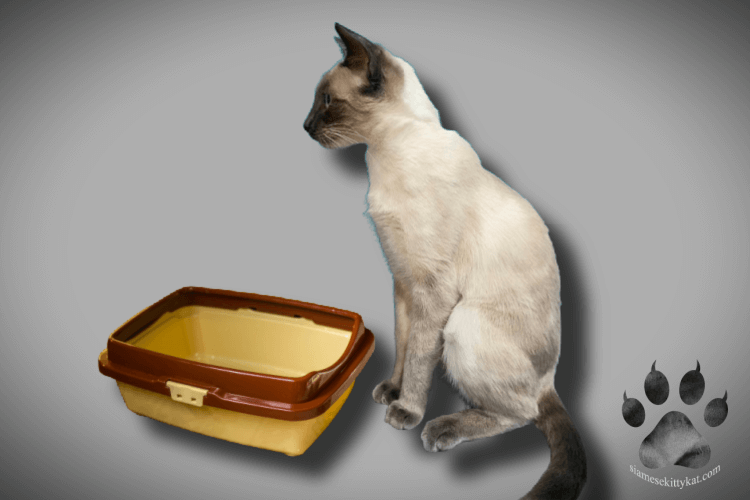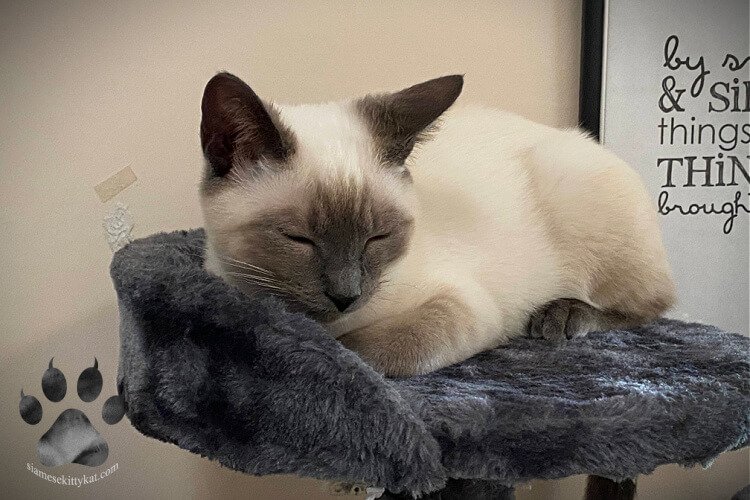All cats are different, but Siamese cats can be temperamental—which is why they make great feline companions! Anyone who has ever lived with a Siamese will tell you they are full of personality and have a stubborn streak. But when it comes to their health, this isn’t always a good thing.
Unfortunately, Siamese cats are prone to urinary problems that can be difficult to treat. So if your cat is causing you trouble in the litter box, read on! In this article, we’ll look at what causes these problems, what warning signs to look for, and what treatments are available.
Do Siamese cats have urinary problems?
Every cat will have health problems at some point in its life, and Siamese cats are no exception.
Siamese cats have urinary problems. Urinary tract infections (UTIs) are one of their most common health problems. These infections occur when bacteria pass into the urethra (the tube that connects the bladder to the outside of the body) and start to multiply. In most cases, the infection will only affect the urethra. But, it can spread to the bladder and kidneys if left untreated.
While any cat can get a urinary tract infection, Siamese cats are more likely to get one due to their anatomy. The Siamese breed has a very thin coat of fur, which means they have less protection against bacteria.
UTIs are more common in female Siamese cats than in males. It is because they have a shorter urethra that allows bacteria to travel up easier. Siamese cats are also more vulnerable because of their long, slender bodies. Because of their deep chest and long abdomen, it is difficult for them to empty their bladder. Thus, this allows the bacteria to grow.
Siamese cats are also susceptible to cystitis, an inflammation of the bladder. Various factors can cause this condition, including stress, infection, or even diet.
Fun Fact! The term “feline lower urinary tract disease” or FLUTD refers to a group of conditions affecting the bladder and urethra—the two parts of the feline urinary system.
What are the common causes of UTI in Siamese cats?
Can a dirty litter box cause UTI?

One of the most common culprits in Siamese cats is a dirty litter box. When Siamese cats are stressed or anxious, they may start to urinate more frequently outside their litter box. If the litter box isn’t clean, they are more likely to get infected. That’s why keeping your Siamese cat’s litter box clean and free of debris is essential.
What food causes UTI in cats?
There are a few different things that can contribute to urinary tract infections (UTIs) in cats, including Siamese cats. One of the biggest culprits is diet.
That’s right! The food you’re feeding your Siamese could be causing their urinary problems! So what kind of food should you avoid?
Here are some of the most common offenders:
1. Dry food. This type of food is most likely the worst offender when it comes to causing UTIs in cats. Dry food contains a lot of carbohydrates but very little moisture. This combination can lead to dehydration, which can in turn cause bladder stones or crystals to form. These can be very painful for your cat and even block their urethra.
2. Canned food. While not as bad as dry food, canned food can still contribute to UTIs. Canned food is often high in sodium and phosphorus, leading to dehydration and urinary tract inflammation.
3. Raw meat. Raw meat can contain bacteria that can cause UTIs. Siamese cats are especially susceptible to this because of their sensitive digestive systems.
4. Table scraps. Table scraps are often unhealthy for cats and can even contain toxins that can make your cat sick. Avoid feeding your Siamese cat table scraps to help prevent UTIs.
Siamese cats can stay healthy and happy with the proper diet. If you’re concerned that your Siamese cat may be at risk for UTIs, consult with your veterinarian to determine the best diet for your cat. They can help you choose a food that will reduce the risk of UTIs and other health problems.
Is wet food better for cats with urinary problems?
When answering this question, there are a few factors to consider. Siamese cats, for example, are prone to urinary problems. So, if you have a Siamese cat, you might consider switching to wet food. Wet food is also generally higher in moisture content than dry food, which can benefit cats with urinary problems.
Another consideration is that different cats have different preferences. Some cats prefer dry food, while others prefer wet food. If your cat has urinary problems, it’s worth trying wet food to see if it makes a difference. Ultimately, it would be best to try a few different things to determine what works best for your cat.
What are the symptoms of a urinary tract infection in a cat?
Cats suffer in silence and try not to draw attention to themselves when they are in distress.
I recall Cleo, one of our Siamese cats, having a stroke. He did not want to bother us. Cats are clean animals. They prefer to use their litter boxes and will not pee and poop in other areas of the house unless their litter box is dirty or something is wrong with their health.
Cleo was so sick that he couldn’t even get into his litter box. He could not walk or even crawl. Cleo had to poop and pee on the towel that we had underneath him. He never complained, though. It was so sad.
If your Siamese cat is having urinary problems, it’s crucial to understand how to identify a urinary blockage.
The following symptoms may show that your cat has a urinary blockage:
Urinary blockages are severe and can be a life-threatening emergency. So, if you have a Siamese cat, it’s essential to be extra vigilant about their urinary health.
Any changes in your cat’s behavior, litter box habits, or eating and drinking habits should be treated as red flags. If you notice any of these signs, you should take your cat to the vet as soon as possible. They can diagnose the problem and suggest the best course of treatment.
How can you treat a cat with urinary problems?

If your Siamese cat has urinary problems, you can do a few things to help your cat feel better.
First, take them to the vet to get a checkup and ensure there isn’t a more serious underlying problem. The vet will most likely perform a urinalysis to look for bacteria or blood in the urine. The vet may also take a culture to identify the specific type of bacteria causing the infection. In some cases, x-rays or ultrasounds may be necessary to check for bladder stones or other abnormalities.
Once the vet confirms the diagnosis, they will prescribe antibiotics to clear the infection. In severe cases, your cat may need to be admitted to the clinic for IV fluids and antibiotics.
Your vet may also recommend simple dietary changes. You can do this by switching to a wet diet or adding supplements to help prevent future infections.
In some cases, increasing their water consumption is essential.
You should also avoid dry foods high in carbs and sugars as they can irritate the bladder.
So if your Siamese is having urinary problems, don’t lose hope! There are treatments available. With the right treatment plan, your Siamese cat can make a full recovery and go on to live a happy and healthy life!
How much does it cost to treat a cat with urinary blockage?
The good news is that there are treatments available for urinary tract infections. The bad news is that they can be expensive. The cost of treatment will depend on what’s causing the problem and how severe it is. A course of treatment will cost you anywhere between $50 and $500 for a course of treatment.
Siamese cats are also susceptible to other urinary problems, such as cystitis and urolithiasis. Treatment for these conditions can be even more costly, ranging from $100 to $500.
How to save money on Siamese cat’s UTI treatment
If you’re considering adding a Siamese cat to your family, be sure to factor in the potential cost of UTI treatment. Siamese cats are beautiful, loving animals, and with proper care they can live longer lives.
Treatment for a UTI usually involves antibiotics, which can be pricey. The good news is that there are several ways to get discounts on antibiotics and other medications for your pet. Here are a few tips:
1. Check with your local animal shelter. Often, these organizations have programs that offer low-cost or free antibiotics for pets.
2. Ask your veterinarian if they know of any discount programs for pet medications.
3. Search online for coupons or promo codes for pet medications. You may be able to find discounts of up to 50% off.
4. Call different pharmacies to compare prices for your pet’s medication.
5. Buy pet insurance for your cat to cover unexpected expenses. It offers you protection in dealing with your pet’s health. Look for companies that provide coverage regardless of the breed. Some may offer comprehensive plans covering common conditions, such as urinary tract infections. Your pet insurance may also cover hospitalizations, diagnostic tests, medications, and emergency care.
It’s crucial to be proactive about preventing and treating UTIs in Siamese cats. Following these tips can help you in saving money on cat UTI treatment.
Can urinary tract infections in cats go away on their own?
Urinary tract infections (UTIs) can be very painful. No one enjoys going to the doctor, including our feline friends. The good news is that UTIs can often go away on their own with some simple home remedies.
Here’s what you need to know about how you can help your furry friend feel better and get on the road to recovery.
You can use a simple test to determine whether your cat is dehydrated. Gently lift the skin on the back of the cat’s neck. Your cat is healthy if the skin bounces back into place. But, if it returns slowly, this is a sign of dehydration.
If you follow these tips, see a noticeable improvement in the condition of your Siamese cat within a few days.
But, if your Siamese cat is still showing signs of a urinary tract infection after trying these home remedies, please consult your veterinarian. Urinary tract infections can be severe and may need antibiotics to clear up.
Conclusion
If your Siamese cat has urinary problems, take them to the vet as soon as possible. The earlier you detect the problem, the easier it is to treat it. Remember that cats are very good at hiding their health problems, So don’t wait until you think something might be wrong before taking your cats in for a checkup. Thank you for reading!
We gathered all the health tips tailored toward maintaining your Siamese cat’s optimal well-being. Check it out here: Siamese Cat Health: A Complete Guide
Get your FREE Siamese Cat 2024 Printable Calendar

